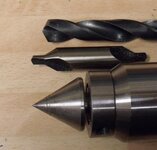Russknan
Member
Thanks to Christmas and the LOML, I am faced with an unexpected conundrum. I am now the proud owner of a Drill Doctor 750X bit sharpener. (Making Tim The Tool Man noises!) And I'm ready to take on a couple of bits (10.5 and 12.5 mm) that have had me holding my breath each time I use them because they are so dull. But now I have the ability to choose whether to grind them at 118 or 135 degrees. And I can even split the points! Easily in over my head here. Any suggestions? Different choice for wood vs acrylic? TIA. Russ

